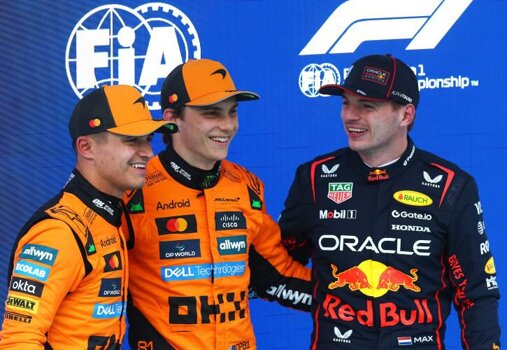Max Verstappen`s aspirations for the Formula 1 championship suffered a notable setback at Sunday`s Spanish Grand Prix. Frustration seemed to get the better of him, leading to contact with George Russell`s Mercedes. This incident resulted in a 10-second time penalty, relegating Verstappen to a 10th-place finish and earning him just a single championship point, despite a podium finish and 15 points having been within reach earlier in the weekend.
Following this outcome, the reigning champion now trails championship leader Oscar Piastri by 49 points and Lando Norris, in second place, by 39 points in the driver standings. When questioned by the media after the race about his race craft, Verstappen was eager to shift the focus away from criticism and onto other topics, including his diminishing title prospects.
“If there`s any hope left, we`re simply too slow to compete for the title anyway,” he stated. “I think that was evident again today.”
Before the Spanish Grand Prix, there had been some cautious optimism from Red Bull, suggesting that more stringent front-wing flexibility tests might impede McLaren`s momentum. However, the championship leader appeared minimally affected by the technical directive, reporting that any performance difference after complying with modifications was negligible compared to typical track-to-track variations.
As anticipated, Piastri and Norris emerged as the dominant force in qualifying at the Circuit de Barcelona Catalunya, going on to secure a comfortable one-two finish in the Sunday race. On the surface, the championship contest now appears more than ever to be a battle between two drivers.
Yet, despite the barrage of negative headlines on Sunday, his subsequent contrite Instagram post on Monday, and a Red Bull car that has been challenging all year, it would be overly bold to completely dismiss Verstappen from the title fight just yet.
Why Verstappen Can`t Be Written Off
Looking back at the first race of F1`s European tripleheader in Imola, the situation seemed considerably different. Verstappen seized the lead from Piastri at the first corner and went on to claim a convincing victory ahead of both McLarens.
Upgrades introduced in Miami and Imola helped Verstappen achieve a better balance in his car. This, in turn, allowed for more effective tire management, enabling him to outpace the McLarens. The subsequent races in Monaco and Spain were less convincing, but these circuits highlighted some of the lingering weaknesses of the Red Bull car and, in Spain`s case, particularly favored McLaren`s strengths.
“In a sense, I`m slightly surprised by the clear advantage we held [in Spain],” commented McLaren team principal Andrea Stella after his team`s most dominant qualifying performance of the season. “Especially considering I expected Red Bull to be somewhat closer, based on circuit characteristics similar to Suzuka or Imola. But in hindsight, looking at the very high temperatures and the primary limitations, which for us were mainly related to the rear axle, I believe that`s where our car performs exceptionally well.”
Managing overheating rear tires has been one of McLaren`s key strengths this season. Before Sunday`s Spanish Grand Prix, this positive trait was also evident in Bahrain, Saudi Arabia, and Miami, to the extent that rivals began speculating that the orange cars might be employing tactics beyond the regulations.
It was perhaps unsurprising, then, that on a scorching and abrasive track surface in Barcelona, McLaren once again held an edge over Verstappen. Furthermore, the heat combined with another significant difference between Spain and Imola helped swing the advantage further in McLaren`s favor.
“To be a bit more technical, one characteristic of Spain is its very long corners, unlike Imola, where corners are relatively shorter,” Stella explained. “And I believe that in these long corners, the MCL39 seems to have retained some of the qualities of its predecessor. Last year, for example, Lando dominated the weekend in Zandvoort, another track featuring long corners.
“So, I think we`ve kept some aerodynamic strengths while improving the car overall. I feel these strengths were particularly beneficial on this type of track, where even if the speed range is similar to others, the length of the corners helped us today.”
Considering McLaren`s inherent advantages at Barcelona, it was perhaps surprising how closely Verstappen managed to stay during the race. Theoretically, Red Bull`s three-stop strategy should have been slower than McLaren drivers` more conventional two-stop approach. However, halfway through the race, Verstappen remained too close for any comfort on the McLaren pit wall.
“He was quick. When we switched to medium tires for the second stint, we were pushing to control the pace, and he was closing in very rapidly, faster than we anticipated,” Stella admitted. “At one point, we even asked our drivers if we should push harder, and both indicated they weren`t sure they had significantly more pace.
“So, at that stage, we were a little concerned that the situation might be more open than we thought after the first stint. Thankfully, Verstappen started to lose pace slightly, and Oscar found considerable speed towards the end of the second stint, which allowed us to manage the pit stop sequence effectively.”
The safety car intervention that followed the final round of scheduled pit stops exposed the inherent risk in Red Bull`s three-stop plan. Verstappen was left with only a set of hard tires to switch to when he was called into the pits. He did have one remaining set of soft tires, but they had already completed laps in qualifying and on the way to the grid before the race, offering minimal advantage over the eight-lap-old softs already fitted to his car.
“The safety car came out on Lap 54, which was probably the worst possible timing for our strategy,” Red Bull team principal Christian Horner stated after the race. “Because you`re then faced with a dilemma: do you stay out on an eight-lap-old, heavily used soft tire, which would result in being easily overtaken at the restart?
“It looked like there would be about 10 racing laps remaining. Unfortunately, the only available set of tires we had, having committed to the three-stop strategy, was a new set of hards. Our assessment was that a new set of hards was preferable to an eight-lap-old, significantly degraded set of softs. So, we made that call.”
What ensued was Verstappen`s widely reported frustration during the final six laps of the race. Up to that point, however, the defending champion had arguably shown greater competitiveness against the McLarens than might have been expected, given the track characteristics and high temperatures.
While Verstappen is correct in suggesting that the performance gap to McLaren seen in Barcelona would make a title challenge prohibitive if it persisted throughout the remaining season, fortunately for the four-time champion (and millions of fans), the remaining 15 races will be held on a variety of circuit types. Upcoming Grands Prix in Canada, Austria, and Great Britain are expected to be more favorable to the Red Bull car and could take place in cooler conditions, making this a crucial period for Verstappen`s championship campaign.
Furthermore, if the competition between the McLaren drivers remains intense, it could create more opportunities for Verstappen, as Norris and Piastri will inevitably take points away from each other.
Had Verstappen finished third in Spain, he would have lost only three points to Piastri over the three races of the tripleheader, despite McLaren`s clear car advantage at two of those events. Naturally, losing three points every three races is insufficient for Verstappen to win the championship, but with the competitive order likely to fluctuate between tracks, it demonstrates that he could maintain a fighting chance by consistently scoring solid results.
This context makes his self-inflicted points loss in Spain all the more frustrating. In addition to the championship points squandered on Sunday, Verstappen will also be walking a tightrope in the next two races, being just one penalty point away from a race ban. Two of the 11 penalty points currently on his super license will expire at the end of June (one year after his incident with Norris at the Red Bull Ring last season). However, in Canada and Austria, a minor infringement could lead to a race on the sidelines, effectively extinguishing his last remaining hopes of a title challenge.
Assuming he avoids further penalties, Verstappen needs to outscore Piastri by an average of 3.27 points per race and Norris by 2.6 points over the final 15 rounds to be crowned champion. Viewed this way, it`s not an insurmountable task, but it will demand near-perfect performances for the rest of the season.
“Look, I think there`s a significant gap now, but there are still a huge number of points available,” Horner commented on Sunday evening when asked if the drivers` title was already out of Verstappen`s reach. “We haven`t even reached the halfway point of the year yet. McLaren are in a very strong position, but we never give up.”









